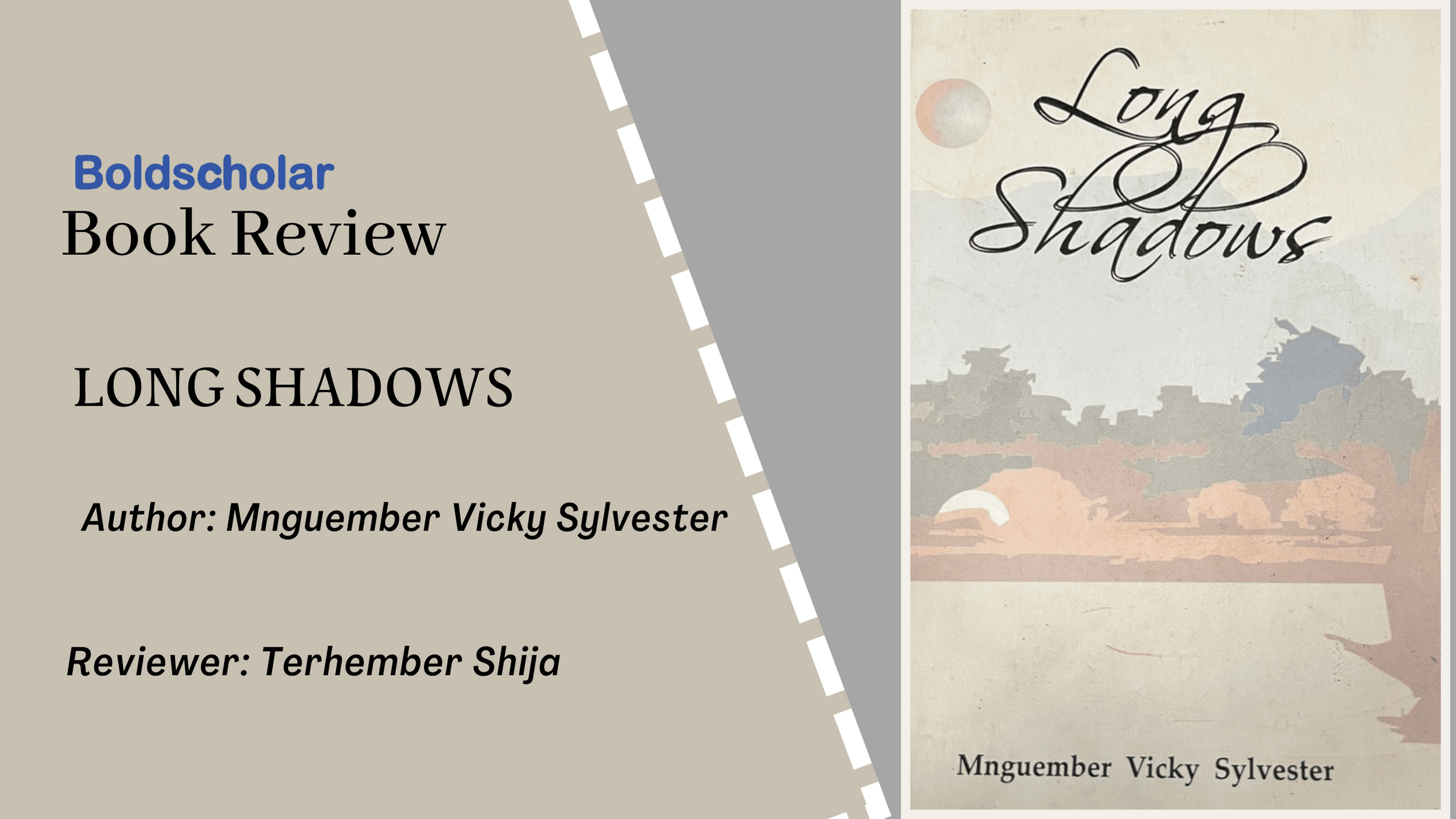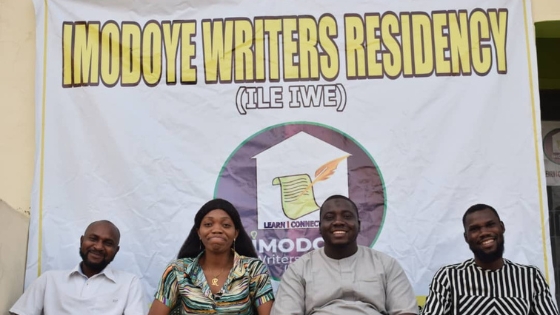Title: Long Shadows
Author: Mnguember Vicky Sylvester
Publisher: Malt House Press Limited, Lagos
Year: 2014
Pages: 224
Reviewer: Terhember Shija
Many great works of literature are produced out of crises, anarchy, conflicts or war, which are as a logical existential reality of man. With tendency towards fatality literary arts appear to celebrate tragedy instead of lamenting it. The novel genre particularly surveys the life of an average man in society and presents how he grapples with the vagaries of social, economic and politic contradictions of his time and how he is invariably overwhelmed by them.
On the recent Nigeria literary scene, there appears to be a resurgence of creative activity on the various national conflicts that had afflicted the country since the attainment of independence in 1960. Works like Chimamanda Ngozi Adichie’s Half of a Yellow Sun (2007) and Chinua Achebe’s There Was a Country (2012) recreate the Nigerian’s Civil War of 1967 to 1970, another challenging moment in Nigeria’s political history which led to the military coup of 1966. This historical reconstruction taking place within the Nigeria fictional world can as well be contextualized within the broader turn of Nigerian politics evidenced in the ethnic and sectional renaissance of Nigeria geo-politics.
Long Shadows is a story of power and disillusionment. It is a depiction of the predicament of the Tiv, a highly decentralized people and late comers in the Nigerian amalgamation; a group of people without traditional royalty in quest for a common agenda and strategy to engage other ethnic nationalism in the new nation.
Sylvester’s novel is ostensibly an epic evocation of Tiv heroism as she gives anthropological and historical accounts of real events, circumstantial details, ethnic biases, stereotypes, customs and traditions that had characterized the Tiv as a unique race in the new Nigerian nation.
There is so much authorial comment in the narrative. The reader feels obliged to listen more to the writer than the actions and statement scores of character she engages on prorata bases to advance her argument for the marginalization of Tiv land. She appears to have no dominant protagonist as she weaves the story around several characters exhibiting the same tendencies.
The novel begins from the rural town of Adikpo and its environs and proceeds to the bigger towns of Gboko and Makurdi and ends at a much more cosmopolitan and serene city of Jos, where the main character, Jime, flees with his family, works at a mining company and lives for seven years. This shift from the rural periphery to the metropolitan centres echoes a number of diametric opposition that have pervaded the narrative till the military takes over in the coup d’etat of 1966.
These include the juxtaposition of two dominant political parties operating in Tiv land at that time, the NPC and the UMBC/AG, the Tiv versus the non-Tiv, the Tax masters versus the tax payers; the majority ethnic groups, the literate versus the illiterate classes, and most importantly, the integrationist versus the segregationist.
The source of the conflict in the novel is best captured by this statement of Hemba, the district head as he addresses his people along side with their representative in government, Suswam, a J.S Tarka-like political figure;
‘Several years ago, our parents and some of us here fought the white men in the Nyanbuan revolts, we couldn’t and still cannot stand the rottenness of colonial administration which balkanize us among inferior people and expect us to cast off our culture for other things distasteful to us. They ask us to pay tax and at the same time ask us to be vassal slaves to neighbours who cannot feed themselves, because they run some Emirate culture …….. I want to also note that a gallant and proud race as ours must maintain its dignity or die defending it. A Native Authority police has been formed and I can assure you that its primary duty is to control minorities like us (p.74).
Inspite of its heavy anthropological and historical pre-occupations, Long Shadows is written with subtle and profound imagery that convey the emotional power and intellectual vigor of the writer. The argument in the novel, which may of necessarily be the author’s is that several years after independence, the Tiv people were drawn back from developing because of activities of the white colonialists and those of the Hausa/Fulani leaders that took over government at independence. This post colonialist is brilliantly introduced, for instance, by the metaphor of the small boy who witnesses the innocuous aggression of the cat against a rat: As she made a corner, she saw a boy trying to take a rat away from the cat, the head already consumed and the cat growling. She called out to the boy.
‘Leave the cat with its meal. Can’t you see it’s already eaten the head?
‘ I was pursuing the rat and she followed me, I allowed her to come because I thought she was helping’……….. The boy ran home in rage. The cat continued with its meal. (P 34 – 35)
The above idea builds up to an allegorical representation of the animal world reminiscent of George Orwel’s Animal Farm in which, the Tiv are depicted as the impregnable Porcupine in a story, the Hausa or the Damkor as the trickish cat while the British colonial master who first colonized Tiv land with artillery fire are depicted as the Dogs. The story as narrated by the grand-mother to Ayima’s children is very critical of the connivances between the white colonial masters and the Hausa majority groups against the survival of the Tiv race.
The author summarizes the story as such;
With this discovery, the frog and cats uttered their service to the dogs promising to help the dogs find their way to porcupine villages. They captured some clans and installed chiefs. They built some places and called them churches and said the porcupine must convert. Some but only because they see they can pick the dogs brains in the schools. (p.44)
It would be simplistic to interpret the author’s invocation of strong ethic sentiments as an end in itself. She consciously sublimates her work beyond the Tiv tribe. The story is a motif exhibiting the challenges of new nations of Africa and the problem of living together in society in which minority identities are stifled.
In the Tiv areas, the UMBC won all the legislative seats in the Northern parliament but the NPC controlled the Regional government in Kaduna and had imposed Native authority government over the Tiv area. The NPC also determined who became a traditional ruler of the Tiv irrespective of his origin. The N.A officials were high handed in to tax collection among the poor farmers. At the beginning of the novel, the traditional ruler of Ajir village is ‘stripped naked in the presence of women and children and is beaten with horsewhips as an example to any Clan that fails to pay taxes’. (P.I). The Tiv youths react angrily to this humiliation, and even without central leadership, organize themselves into militia groups to wade off any more of such acts.
The bubble finally bursts when a riot ensues as the northern Regional Government attempts to install a non-Tiv as a traditional ruler over the people of Katsina-Ala and several people are gruesomely murdered by the N.A police as the youths protest.
The well-respected and idealistic traditional ruler, Hemba is also murdered in the fracas. As a traditional ruler, he combines well with Iortyo, his friend and fellow World War II veteran who serves as a councillor and Suswan, their political leader, to give general direction to the elites of Tiv land. His death triggers a rapid sequence of events, throwing up the incorrigible guerrilla warrior, Biri and the more considerate and intellectual, Gums, who intelligently engages both sides of the warring parties with considerable results.
He is able to save Ayina, Jime’s wife and children as well as Maria and Mary, the ‘twin’ girls who are wives of John and Peter from destruction. There are extreme emotions of fear and pity elicited when Hali, the pretty and lively girl of Adikpo and Orya’s wife are killed in the riots. Orya superbly retaliates his wife’s killing by Biri in a James Bond-like style in the house of his beautify girl friend.
Although, a seam of violence and fear runs through the whole novel, there does not appear to be a logical defining war line in the conflict, nor a properly organised guerrilla army like the Mau-Mau revolts of Kenya captured in Ngugi wa thiongo’s works. It is indeed a free for all fight among the poor people of Tiv land. We are unable to see the gains of the war on the Tiv population or even the sophistication of the much talked-about war likeness of the Tiv youth. The political leader, Suswan, is variously presented as a member of parliament, a minister and aspiring president yet he is unable to pacify the situation.
We notice that the elites find everything easy going for them as they easily secure government jobs in NA office, schools and ministries. Jime escapes to Jos and is immediately engaged in the Tin mining company owned by a European. His salary is quite generous. He builds his family house and settles his family in Jos. This ironic portrayal of senseless hostilities among the Tiv is interrogated by Erdoo, the eleven year old daughter of Jime when she questions her father as such;
‘Why did they kill themselves instead of the enemy? (p.223)
Apart from the idea of the futility of war, Sylvester’s next daring preoccupation is the portrayal of women in Tiv as truly free of the economic, political and psychological inhibitions that characterize most African societies. The women in the novel have little or no education but are certainly not idle or lazy.
They are described as always doing something, gardening, writing something or talking excitedly to visitors. Awange runs a beer palour and also organizes women discussion groups to enlighten them on current political matters; Ayima, Jime’s wife is a very talented seamstress who endears herself to all customers; Dooshima, the ‘tall broad, light skinned and handsome woman is a skilful beads maker who beats up her husband mercilessly at night and pretends to be a victim in the day time. Maria and Mary are responsible housewives, farmers and traders who work tirelessly to earn money to support their husbands. With little or no education, these women seem to be politically conscious as they compare notes with other activists in Nigeria. The author says;
Awange often sat with Ayima to discuss women they admired like the Fumilayo woman of Abeokuta and often cited her as an exemplary woman doing what they should also be doing even though the issues were slightly different but at this moment Awange was sure the women needed some talking to and Ayima would serve the purpose. The women had to plan strategies to protect themselves first before their children. (p.33)
The women in Long Shadows are also women of honour who are prepared to pay any prize for their sanctity. Awange reiterates their philosophy in the following words: ‘sometimes you kill to protect yourself and your children. It is not a sin. Have something handy and don’t be squeamish. A man who tries to rape or kill you is no better than a rabbit. Do with him what you do to a rat.’ (p.37).
Accordingly, Torkwase, a housewife outsmarts an N.A policeman who attempts to rape her at gunpoint and kills him (p.16). Nguhemen, the proud wife of Agbo, the disgraced clan head, poison him with a mushroom meal and he dies because she cannot stand the shame of a clan head, her husband being beaten and humiliated by the Damkor tax raiders.
Perhaps the most natural expression of feminist psychological liberty is found in the discussion of the riots at the marketplace between two village women in which one of them said;
‘Unenge kwagh je ikyarkyase a gbidye u ken ikur’
Which means ‘shilvers will run through your vagina, when you see what is happening (p.75). Such pattern of speech epitomize not just vulgarity but the courage to humour what had hitherto been held in awe. These women do not have any reservations in asserting the vagina at the centre of discourse in an essentially phallogencentric society like ours.
Sylvester’s Long Shadows is certainly a major contribution to African literature more particularly because of its elevated style of rendition. It is not merely a romantic recreation of Tiv history and anthropology, but an art novel which is deeply congested with ideas about ethnic recriminations, colonialism and neo-colonialism. The author deploys devices like interior monologue, flashbacks and stream of consciousness which render the flow of the story-line very cumbersome. This novel simply would not yield its meaning and coherence so easily without a rigorous intellectual exercise by the reader.
It ends up interrogating local heroism and ethnic nationalism and embraces the integrationist option which is an essential catalyst in the development of the country. Her hero, Jime secures a good life in Jos due to his friendship with a non-Tiv and is sponsored by a Whiteman, son of a former colonial master for medical treatment in England.
This is no doubt, a highly successful novel with great significance to the emerging nationalities and economics of Africa and the third world. It is also a work with bold and stimulating craft that should engender various layers of meanings each time you read it.
I have no hesitation at this point to recommend this outstanding book, Long Shadows by Mnguember Vicky Sylvester to teachers and students of the Departments of Literature, History, Political Science, and Sociology in Universities and other tertiary institutions as well as the general reader
Share this post




Be the first to comment on this post